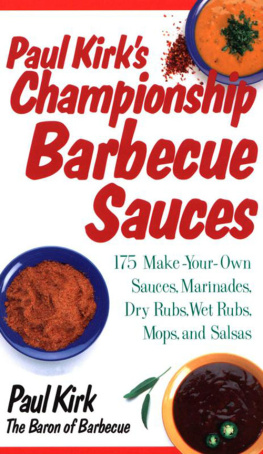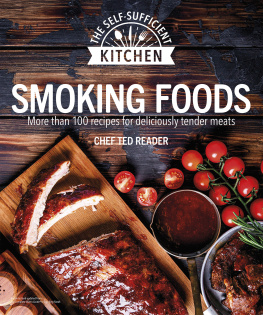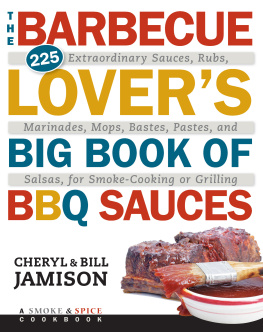The Harvard Common Press
535 Albany Street
Boston, Massachusetts 02118
Copyright 1998 by Paul Kirk
Illustrations copyright 1998 by Chris Van Dusen
All rights reserved. No part of this publication may be reproduced or transmitted in any form or by any means, electronic or mechanical, including photocopy, recording, or any information storage or retrieval system without permission in writing from the publisher.
Printed in the United States of America
Printed on acid-free paper
Library of Congress Cataloging-in-Publication Data
Kirk, Paul.
Paul Kirk's championship barbecue sauces : 175 make-your-own sauces, marinades, dry rubs, wet rubs, mops, and salsas / Paul Kirk.
p. cm.
Includes index.
ISBN 1-55832-124-1 (alk. paper).ISBN 1-55832-125-X
(pbk.: alk. paper)
1. Barbecue cookery. 2. Barbecue sauce. 3. Marinades. 4. Cookery (Salsas) I. Title
TX840.B3K454 1997
641.5'784dc21 97-006626
978-1-55832-125-0
Book design by Joyce C. Weston
Cover photographs by Kimberly Grant
Illustrations by Chris Van Dusen
Special bulk-order discounts are available on this and other Harvard Common Press books. Companies and organizations may purchase books for premiums or for resale, or may arrange a custom edition, by contacting the Marketing Director at the address above.
20 19 18 17 16
For Jessica, Todd, Chrissy, and Erin

Acknowledgments
I want to thank my mother and father for my love and appreciation of good food. Thanks to my wife, Jessica, and my children, Todd, Chrissy, and Erin, my biggest fans. Thanks also to the rest of my family, Mary Beth, Cathy, Tom, Marty, Jenny, and Joyce, for all of their encouragement. I would like to acknowledge the barbecue public for its quest for greater and greater barbecue, and for living up to the Backyard Barbecue Creed, "Always Strive to Make Your Barbecue Better." And, finally, I want to thank the one who is most responsible for getting this cookbook written and published, my patron saint, St. Judethe Saint of the Impossible!
Introduction
There's a Peace Corps motto that goes "Feed a man a fish and feed him for a day. Teach a man how to fish and feed him for life." My motto is "If you give people barbecue, they will eat and enjoy it once. Teach people to barbecue, they will eat and enjoy barbecue for the rest of their lives. " So this is a book that tells you what I think you need to know about barbecue. Better yet, it's a barbecue cookbook!
This book is a collection of recipes developed over fifteen years of competition barbecue and five years of The Baron's School of Pitmasters, which I have conducted all over the country. Some of the secrets I reveal here are the same ones that helped me win seven world barbecue championships. They've also helped my students go on to win thirty-five state barbecue championships and three world barbecue championships.
Knowledge of barbecue is like a man and his money: The more he learns about barbecue, the more he craves it!
This book is a guide for beginners to help them develop their own barbecue. The barbecuers who "know it all" can still get a good deal of enjoyment from this book. As the famous barbecuer William Shakespeare once said, "Doubt is called the beacon of the wise." So when I tell you to use this book as a starting point and not as gospel, you will know what I mean.
If you already have your barbecue pit set up and you know about lighting fires and all the rest of Barbecue 101, then you can skip ahead to whatever recipe chapter you want. Don't feel you have to keep reading. But if you're the kind of person who likes to take things one step at a time, here's the basic information for getting started with barbecue.
Equipment
When I barbecue, I do far more indirect cooking than I do grilling, meaning the meat is cooked slowly by smoke over a fire that has burned down to coals. The meat sits over a drip pan, not directly above the coals, to prevent flare-ups from fat dripping onto the fire. Most cookers can be set up for this style of cooking, such as a pit or barrel barbecue, a kettle grill, or a smoker. (For sources, see Resources.)
Some 85 percent of all American households own one or more type of barbecue cooker. Of that 85 percent, 65 percent own a charcoal grill and 54 percent own a grill fueled by gas.
A water smoker is a tall, cylindrical oven that looks like a silo. You burn charcoal and wood in the bottom and a water pan sits above the coals. The food sits on a grate over the water pan and cooks in a combination of smoke and steam, or heat and moisture. You get good smoke flavor from water smokers, and the food is almost always moist and tender. As for pit smokers, there are a lot of different styles and models available, but they all have the same basic features. A firebox that handles wood chips, chunks, or logs is offset from the cooking area, which is basically a smoke chamber. Some pits have water chambers, which help to keep the meat moist. Before you invest in any pit, shop around. Consider prices, and the quality and gauge of the metal.
The most common type of barbecue is probably the kettle grill. Most people burn only charcoal in a kettle grill, but you can burn a combination of charcoal, wood chips, and wood chunks. You can get the same strong wood-smoke flavor from a kettle grill as you can from a log-burning pit. To barbecue in a kettle grill, you light the charcoal and let the coals burn down to a gray ash color. Then you push the charcoal to one side and place a drip pan filled with water on the other side. Place a handful or two of well-soaked wood chips or chunks on the coals, and set your food on the grate above the water pan or to the side of the hot coals. The food can be placed anywhere on the grate, so long as it is not above the coals. Then close the lid and cook. It helps to position a thermometer in one of the exhaust vents so you can monitor the cooking temperature. Meats are cooked at temperatures between 230 and 250F. I recommend that you keep the temperature inside your pit, smoker, or grill within this range for any type of meat you are cooking. Only the cooking time should vary for different types of meat.
As far as gas and electric grills go, I have a lot of fun at the expense of their owners. Someone in my class will say, "I have a gas or electric grill," and I grab for my heart just like Redd Foxx did and say, "Elizabeth, it's the big one." But in reality, if I had a gas or electric grill at home, I would use it for grilling. Don't tell anybody (it might ruin my image), but I have used both and I like them. For grilling, that is, not for smoking.
Since most of the rubs and barbecue seasonings that I use have sugar in them, they can caramelize if they get too hot. You can still use them when cooking over hot coals or on a gas or electric grill, though, by making two adjustments: lowering your cooking temperature a little, and turning the meat more frequently. For example, if you usually cook the meat over medium-high heat and turn it at 20-minute intervals, then lower the heat to medium and turn it every 12 to 15 minutes. If someone says that you're not doing real barbecue if you are charcoal grilling or using a gas or electric grill, just thank him or her for the opinion and go right on enjoying your barbecue. What that person doesn't realize is that you like the barbecue you serve. Your family and friends think it's the best barbecue since time began, and you know that it is!
Fuels
It stands to reason that if whatever you're barbecuing is cooked by the heat of the charcoal and the flavor of the smoke, the kind of smoke you are generating is going to make a difference in the taste of the meat. Personally, I like to smoke with oak and apple wood. Both oak and apple have a fruity and subtle flavor, with apple being the more exotic of the two. Some barbecuers just swear by oak. Cherry, hard maple, pecan, hickory, and mesquite are all good, flavorful woods, but their smoke will darken the meat if you overuse it. Alder is another good wood to use, if you can get it.
Next page




![Raichlen - Barbecue Sauces, Rubs, and Marinades—Bastes, Butters & Glazes, Too [eBook - Biblioboard]](/uploads/posts/book/229830/thumbs/raichlen-barbecue-sauces-rubs-and.jpg)

